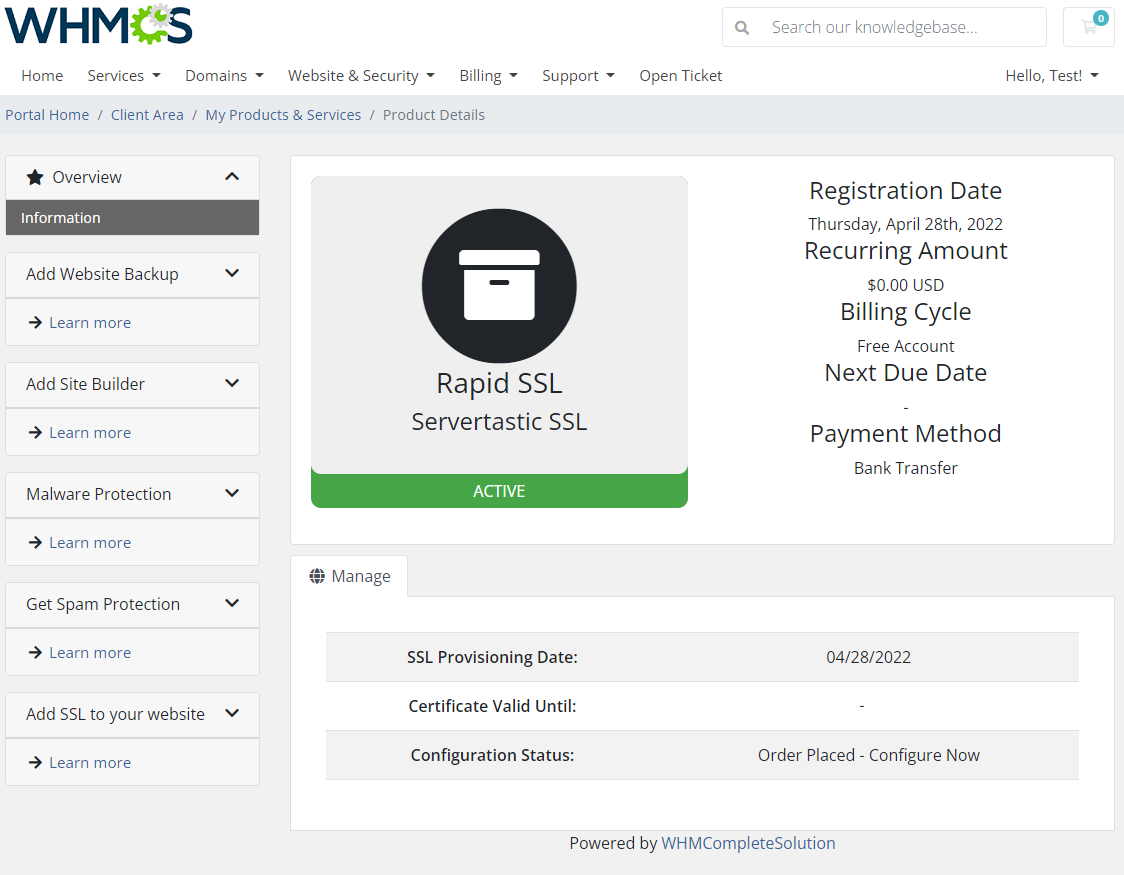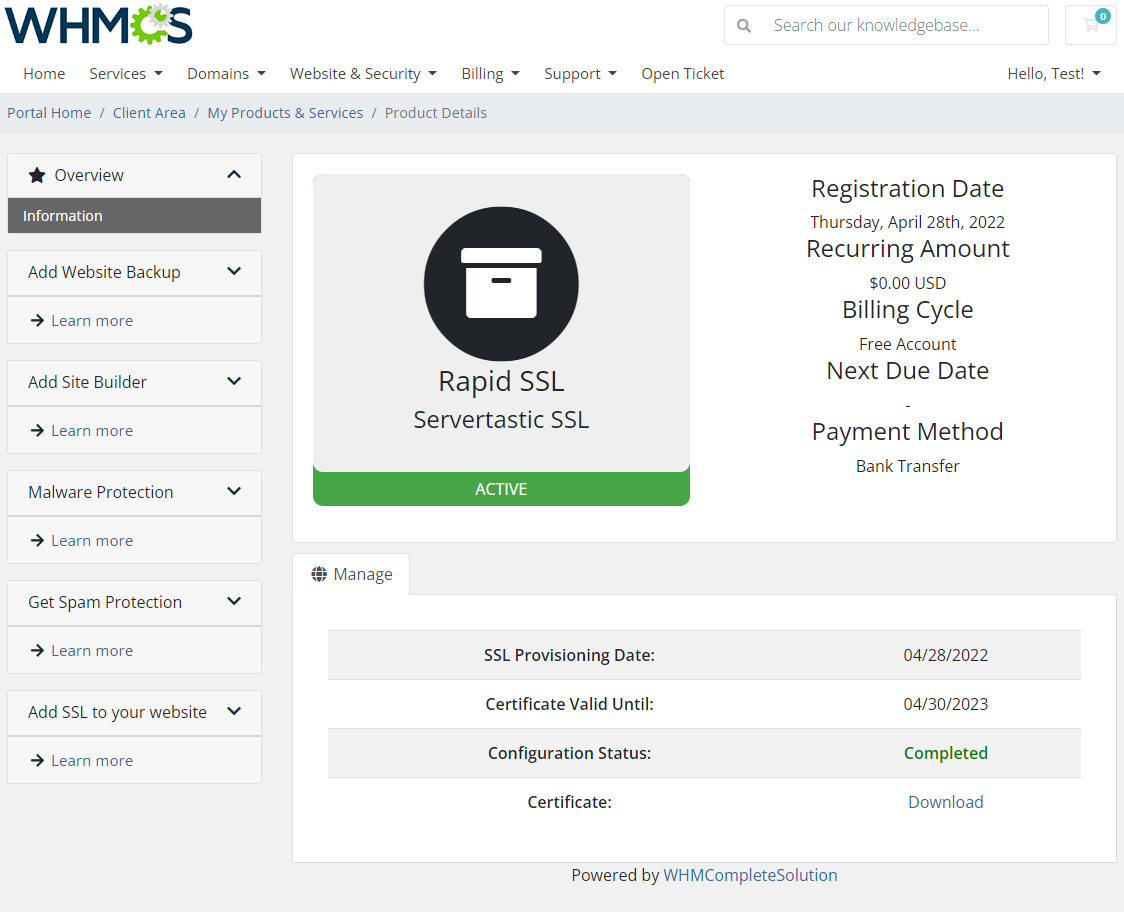Hosting Quota Notifications 1.X For WHMCS
(→Tips) |
(→cPanel Integration) |
||
| Line 272: | Line 272: | ||
=cPanel Integration= | =cPanel Integration= | ||
{| | {| | ||
| − | |style="padding: 10px 0px | + | |style="padding: 10px 0px 15px 15px;"|To enable the selling of certificates with [https://www.modulesgarden.com/products/cpanel/servertastic-ssl Servertastic SSL For cPanel] module, configure the generation of tokens using the module in WHMCS. <br/> |
In this way, WHMCS will bill customers for the ordered certificates and generate tokens, which can then be used by customers to add their certificates in cPanel. | In this way, WHMCS will bill customers for the ordered certificates and generate tokens, which can then be used by customers to add their certificates in cPanel. | ||
| + | <br/><br/> | ||
| + | |||
| + | To start selling tokens for cPanel certificates you need to add a new product in the same way as described in the '' '[https://www.docs.modulesgarden.com/Servertastic_SSL_For_WHMCS#Configuration_of_Product Configuration of Product]' '' section.<br/> | ||
| + | Select the '' 'ServerTasticToken' '' from the module settings, enter your '' 'API Kay' '' found in step 9 and save the settings.<br/> | ||
| + | |} | ||
| + | {| | ||
| + | |style="padding: 0px 0px 20px 25px;"|[[File:ST_25.png]] | ||
| + | |} | ||
| + | {| | ||
| + | |style="padding: 10px 0px 15px 15px;"|After saving the settings in '' 'Product Type' '' dropdown, available certificates will appear.<br/> | ||
| + | '' '''Note:''' If you are using test API key, first make sure that the 'Use test API' option is enabled.''<br/><br/> | ||
| + | Then set the remaining options corresponding to the selected certificate: | ||
| + | *'''SAN Values''' - enter how many domain names can protected with a single certificate. Make sure it is supported by the selected type of certificate. | ||
| + | *'''Server Count''' - enter how many different servers can indicate the domains protected by the certificate. Make sure it is supported by the selected type of certificate. | ||
| + | *'''Management Page Link''' - Specify the address at which the customer will be able to see the generated certificate directly in the '' 'Servertastic' '' panel. | ||
| + | *'''Show Order Management Page link''' - select whether you want to show your customers a direct link to the certificate in the '' 'Servertastic' '' panel. | ||
| + | Finally, save the changes and do not forget to generate '' 'Custom Field' and '' 'Email Template' ''. | ||
| + | {| | ||
| + | |style="padding: 0px 0px 20px 25px;"|[[File:ST_26.png]] | ||
|} | |} | ||
Revision as of 12:44, 1 December 2017
Contents |
About Servertastic SSL For WHMCS
| Servertastic SSL For WHMCS will allow you to offer SSL certificates to your clients. They will be able to define and order a certificate directly in the client area. Moreover, the module will give you the access to SSL configuration details as well as enable you to terminate certificates and renew them after their expiration date. |
- Admin Area Features:
| ✔ Create Certificate |
| ✔ Terminate Certificate |
| ✔ Resend Configuration Email |
| ✔ Renew Certificate |
| ✔ Change Approver Email |
| ✔ View And Edit Order ID |
| ✔ View Certificate Status |
| ✔ Choose Certificate Type |
| ✔ Toggle Synchronization Of Expiration Date |
- Client Area Features:
| ✔ Configure Certificate |
| ✔ View Basic Certificate Details |
| ✔ Modify Approver Email |
| ✔ Download Generated Certificate |
- Configurable Options:
| ✔ Additional SAN Domain |
| ✔ Server Count |
| ✔ Certificate Validity |
| ✔ Certificate Type |
- General Info:
| ✔ Renewal Support - Automatically Creates New Certificate For Recurring Products After Expiration Date |
| ✔ Multi-Language Support |
| ✔ Supports PHP 5.4 Up To PHP 7 |
| ✔ Supports WHMCS V6 And V7 |
Installation and Configuration
| This tutorial will show you how to successfully install and configure Servertastic SSL For WHMCS. We will guide you step by step through the whole installation and configuration process. |
Installation
| 1. Log in to your client area and download Servertastic SSL For WHMCS. |

|
| 2. Upload and extract the module into the main WHMCS directory. Files in your WHMCS directory should look like this. |

|
Configuration of Product
| 4. In order to create and configure a product, go to 'Setup' → 'Products/Services' → 'Products/Services' . Click on 'Create a New Group' . |

|
| 5. Enter product group name and press 'Save Changes' . |

|
| 6. When you have a product group, you can create your product. To create a product click on 'Create a New Product' . |

|
| 7. Afterwards, choose your product group and type from dropdown menus, fill in your product name and press 'Continue' . |

|
| 8. Now, go to 'Module Settings' section, choose 'Servertastic SSL' from a dropdown menu. Next, click on 'Save Changes' . |

|
| 9. Finish by filling in 'API Key' and selecting desired certificate type. To obtain 'API Key' log in to your 'Reseller Panel' and click 'View your API Key' : |

|
| Additionally, mark 'Update Next Due Date' if you want to renew the certificate after reaching its expiration date (recurring products only). Confirm through pressing 'Save Changes' . |

|
| Congratulations! Your module is ready for use. |
Management
| Servertastic SSL For WHMCS allows you to offer fully configurable Servertastic certificates to your clients. Additionally, you have the ability to view certificate details and manage each provisioned certificate. |
Admin Area
| In the admin area you can view the details of a product and find SSL configuration status. Additionally, you can create/terminate product, resend configuration email and even change approver email. |

|
| In order to change approver email, fill in a new email and press 'Save Changes' as shown on the screen below. |

|
Client Area
| Servertastic SSL For WHMCS allows your customers to order and configure SSL certificates. As you can see on the following screen, it also allows to choose from configurable options during an order. |

|
Configuration
| A new SSL certificate needs to be configured before it can be used. Press 'Configure Now' to proceed, you will be forwarded to an external page. |

|
| In the end of the process, you will receive a configuration email. As soon as you receive the email and go to the approval site, your certificate will be generated. |

|
Management
| On the following screen you can see a successfully configured product. Here you can find provision and expiration dates, and its status. |

|
| Additionally, you can download the certificate. |

|
Configurable Options
| The module enables you to set up configurable options allowing clients to define the products they order. Below you can find the list of configurable options with descriptions of how they will affect an order: |
| 1. Let's create configurable options group containing each one of presented configurable options. Start by proceeding to 'Setup' → 'Products/Services' → 'Configurable Options' and pressing 'Create a new Group' . |

|
| 2. Afterwards, fill out the form with a group name and a description, select products you wish to apply to this group by holding Ctrl and clicking on each of the products. Afterwards, press 'Save Changes' . |

|
| 3. Press 'Add New Configurable Options' . |

|
| 4a. (Years, Servers Count, SAN Count) Now, fill in option name, select 'Quantity' option type and fill in minimum and maximum allowed quantity. Afterwards, set up price per one unit and press 'Save Changes' . |

|
| 4b. (Certificate Type, Years, Servers Count, SAN Count) Fill in option name and select 'Dropdown' from option type. |

|
| 5. Now, you have to add each option separately. Do it by filling in its name, setting up its price and pressing 'Save Changes' for each of the options. |

|
| 6. Now, let's order a product using previously created configurable options. As you can see, using configurable option allows you to use fewer product while still allowing a full customization of the product. |

|
cPanel Integration
| To enable the selling of certificates with Servertastic SSL For cPanel module, configure the generation of tokens using the module in WHMCS. In this way, WHMCS will bill customers for the ordered certificates and generate tokens, which can then be used by customers to add their certificates in cPanel.
To start selling tokens for cPanel certificates you need to add a new product in the same way as described in the 'Configuration of Product' section. |

|
